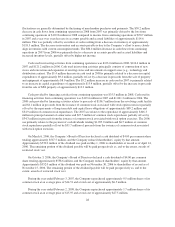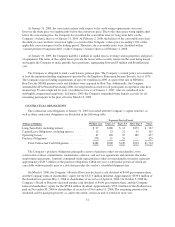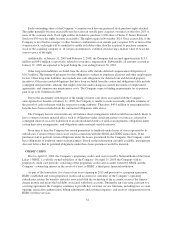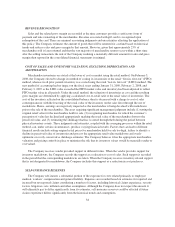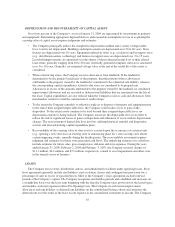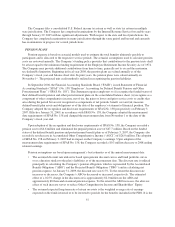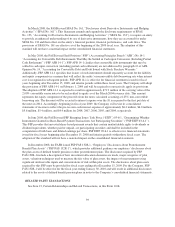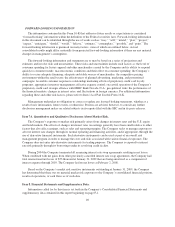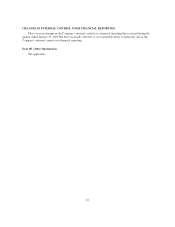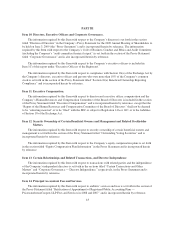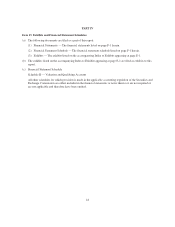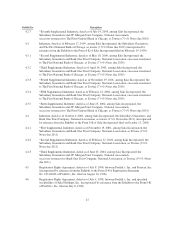Saks Fifth Avenue 2008 Annual Report Download - page 38
Download and view the complete annual report
Please find page 38 of the 2008 Saks Fifth Avenue annual report below. You can navigate through the pages in the report by either clicking on the pages listed below, or by using the keyword search tool below to find specific information within the annual report.The Company files a consolidated U.S. Federal income tax return as well as state tax returns in multiple
state jurisdictions. The Company has completed examinations by the Internal Revenue Service for taxable years
through January 29, 2005 with no significant adjustments. With respect to the state and local jurisdictions, the
Company has completed examinations in many jurisdictions through the same period and beyond and currently
has examinations in progress for several jurisdictions.
PENSION PLANS
Pension expense is based on actuarial models used to estimate the total benefits ultimately payable to
participants and is allocated to the respective service periods. The actuarial assumptions used to calculate pension
costs are reviewed annually. The Company’s funding policy provides that contributions to the pension trusts shall
be at least equal to the minimum funding requirement of the Employee Retirement Income Security Act of 1974.
The Company may provide additional contributions from time to time, generally not to exceed the maximum
tax-deductible limitation. Beginning in fiscal year 2008, the pension plans are valued annually as of the
Company’s fiscal year-end balance sheet date. In prior years, the pension plans were valued annually on
November 1st. The projected unit credit method is utilized in recognizing the pension liabilities.
In September 2006, the Financial Accounting Standards Board (“FASB”) issued Statement of Financial
Accounting Standards (“SFAS”) No. 158 “Employers’ Accounting for Defined Benefit Pension and Other
Postretirement Plans” (“SFAS No. 158”). This Statement requires employers to (i) recognize the funded status of
their defined benefit pension and other postretirement plans on the consolidated balance sheet, (ii) recognize as a
component of other comprehensive income, net of tax, the gains or losses and prior service costs or credits that
arise during the period but are not recognized as components of net periodic benefit cost and (iii) measure
defined benefit plan assets and obligations as of the date of the employer’s statement of financial position. The
Company adopted the recognition and disclosure requirements of SFAS No. 158 prospectively on February 3,
2007. Effective January 31, 2009, in accordance with SFAS No. 158, the Company adopted the measurement
date requirements of SFAS No. 158 and changed the measurement date from November 1 to the date of the
Company’s fiscal year end.
Upon adoption of the recognition and disclosure requirements of SFAS No. 158, the Company recorded a
pension asset of $4.6 million and eliminated the prepaid pension asset of $47.7 million. Based on the funded
status of the defined benefit pension and postretirement benefit plans as of February 3, 2007, the Company also
recorded a net decrease in Accumulated Other Comprehensive Income (“AOCI”) of $26.0 million. The adoption
of SFAS No. 158 on February 3, 2007 had no impact on the Company’s earnings. Upon adoption of the
measurement date requirements of SFAS No. 158, the Company recorded a $0.3 million decrease to 2008 ending
retained earnings.
Pension assumptions are based upon management’s best estimates as of the annual measurement date.
• The assumed discount rate utilized is based upon pension discount curves and bond portfolio curves
over a duration similar to the plan’s liabilities as of the measurement date. The discount rate is utilized
principally in calculating the Company’s pension obligation, which is represented by the Accumulated
Benefit Obligation (“ABO”) and the Projected Benefit Obligation (“PBO”) and in calculating net
pension expense. At January 31, 2009, the discount rate was 6.5%. To the extent the discount rate
increases or decreases, the Company’s ABO is decreased or increased, respectively. The estimated
effect of a 0.25% change in the discount rate is approximately $2.0 million on the ABO and
approximately $8 thousand on annual pension expense. To the extent the ABO increases, the after-tax
effect of such increase serves to reduce Other Comprehensive Income and Shareholders’ Equity.
• The assumed expected long-term rate of return on assets is the weighted average rate of earnings
expected on the funds invested or to be invested to provide for the benefits included in the PBO. It is the
37



